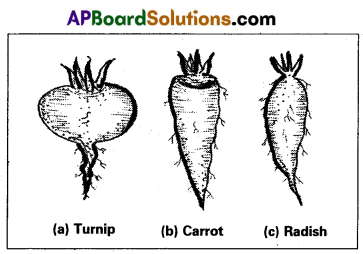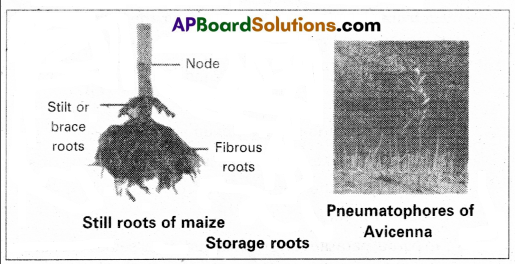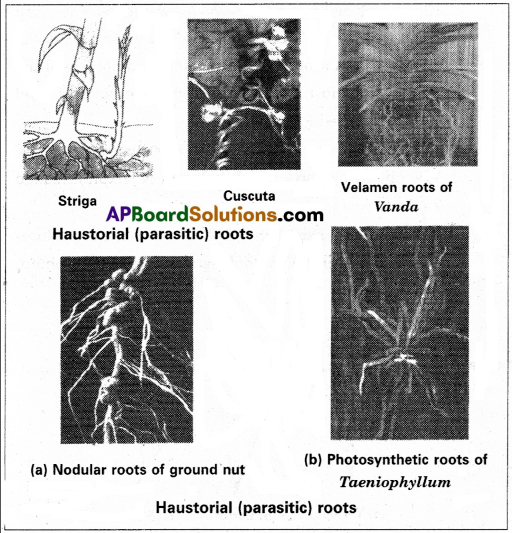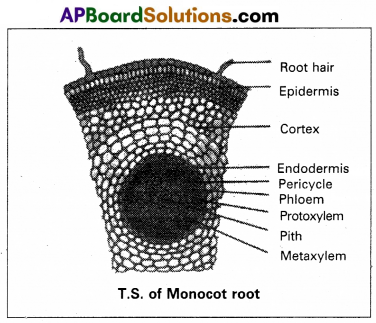Successful navigation through TS Inter 1st Year Botany Model Papers and TS Inter 1st Year Botany Question Paper May 2017 builds students’ confidence in their exam-taking abilities.
TS Inter 1st Year Botany Question Paper May 2017
Time: 3 Hours
Maximum Marks: 60
General Instructions:
Note : Read the following instructions carefully.
- Answer all questions of Section ‘A’. Answer any six questions out of eight in Section ‘B’ and answer any two questions out of three in Section ‘C’.
- In Section A’, questions from Sr. Nos. 1 to 10 are of “Very Short Answer Type”. Erach question carries two marks. Every answer may be limited to 5 lines. Answer all the questions at one place in the same order.
- In Section ‘B’, questions from Sr. Nos. 11 to 18 are of “Short Answer Type”. Each question carries four marks. Every answer may be limited to 20 lines.
- In Section ‘C’, questions from Sr. Nos. 19 to 21 are of “Long Answer Type”. Each question carries eight marks. Every answer may be limited to 60 lines.
- Draw labelled diagrams whereever necessary for questions in Sections ‘B’ and ‘C’.
Section – A (10 × 2 = 20)
Note : Answer all questions. Each answer may be limited to 5 lines.
Question 1.
Who discovered the cell ? What was the book written by him ?
Answer:
The cell was discovered by “Robert Hooke”. He wrote a Book “Micrographia”.
Question 2.
What are the first organisms to colonize rocks ? Give the generic name of the moss which provides peat
Answer:
Moss plants, sphagnum.
Question 3.
Name two diseases caused by Mycoplasma.
Answer:
Witches broom in plants, pleuropneumonia in Cattle.and Mycoplasma urethritis in Human beings.
![]()
Question 4.
Needle like phylloclades are found in which plant ?
Answer:
Casuarina.
Question 5.
Differentiate actinomorphic from zygomorphic flower.
Answer:
| Actinomorphic | Zygomorphic |
| 1. The flower can be cut into two equal halves in any plane is called actinomorphic flower. Ex : Datura |
1. The flower can be cut into two equal halves in one longitudinal plane only is called zygomorphic flower. Ex : Bean |
Question 6.
What is geocarpy ? Name the plant which exhibits this phenomenon.
Answer:
Development of fruits inside the soil is called Geocarpy. It is between in Arachis hypogea (Ground nut).
Question 7.
What is referred to as Satellite chromosome ?
Answer:
A few chromosomes have non staining secondary constriction at a constant location which gives the appearance of a small fragment called satellite. The chromosome with satellite is called satellite chromosome [SAT Chromosome].
Question 8.
Select an appropriate chemical bond among ester bond glycosidic bond, peptide bond and hydrogen bond. Write against each of the following :
a) Polysaccharide
b) Protein
c) Fat
d) Water
Answer:
a) Polysaccharide : Glycosidic bond
b) Protein : Peptide bond .
c) Fat : Ester bond
d) Water : Hydrogen bond
Question 9.
If a tissue has at a given time 1024 cells, how many cycles of mitosis had the original parental single cell undergone ?
Answer:
10 mitotic divisions.
Question 10.
Define population and community ?
Answer:
A group of similar Individuals belonging to the same specieg sound in an area is called population. An assemblage of all the populations occuring in an area is called community.
![]()
Section – B (6 × 4 = 24)
Note : Answer any six questions. Each answer may be limited to 20 lines.
Question 11.
Explain binomial nomenclature.
Answer:
Naming the plants with two words is called Binomial nomen clature. It was first inroduced by Gaspad Bauhin (1623) but the credit goes to Linnaeus (1753).
In Binomial nomenclature, each and every plant has a name, with two words, they should be in Latin. The first word in Genus and the second word is Species. The generic name will be in noun form and always starts with capital letter. The specific name will be in adjective form and starts with small letter. The Botanical name Should be printed in Italics and should be underlined. Ex: Solanum – tuberosum – Potato plant in which Solanum is the generic name and tuberosum is the species name.
Question 12.
What are the characteristic features of Euglenoids ?
Answer:
- Most of the Euglenoids are fresh water organisms found in stagnant water.
- They have a protein rich layer called pellicle which makes body flexible.
- They have two flagella, a short and a long one.
- The anterior part of the cell bears an in vagination consisting of cytostome, cytopharynx and reservoir.
- Eye spot is present in the reservior.
- They behave as Heterotrophs when deprived of sunlight.
- The reproduction in by longitudinal binary fission.
Question 13.
List the changes observed in angiosperm flower subsequent to pollination and fertilization.
Answer:
- Calyx, corolla, stamens, style and stigma wither away.
- Ovary develops into fruit.
- Ovules develops into seeds.
- The zygote develops into an embryo.
- Primary endosperm nucleus develops into endosperm.
- The synergid and 2 antipodals digenerate after fertilisation.
- Funicle of the ovule develops into stalk of the seed.
- Outer integument Of the ovule changes into testa (Outer seed coat).
Inner integument of the ovule changes into tegmen (inner seed coat). - Micropyle of the ovule chaijges into seed pore.
- Hilum changes into scar of the seed.
Question 14.
Give economic importance of plats belonging to Fabaceae.
Answer:
Economic importance :
- Pulses like red gram (Cajanus cajari), black gram (Phaseolus mungo), green gram (Phaseolus aureus) , Bengal gram (Cicer arietinum) are rich source of proteins.
- Pods of Dolichos, Glycine are used as vegetables.
- Seeds of Pisum and Arachis are edible.
- Groundnut oil from Arachis hypogaea seeds and soyabean oil from seeds of Glycine max are used in cooking.
- The oil cake from Arachis hypogaea is used as fodder.
- The oil from the seeds of Derris indica is used in the making of medicines.
- Goldsmiths use the seeds of Abrus precatorius for weighing.
- Several crops are used in crop rotation due to their nitrogen fixing ability.
- Seeds of Trigonella are used as condiment and medicine. The leaves are used as vegetable.
- Sesbania and Tephrosia are used as green manure.
- Crotalaria and Phaseolus are used as fodder.
- Fibre from Crotalaria is used in making ropes.
- Indigofera yields blue dye, which is used as a fabric whitener.
- Wood from pterocarpus is used for making musical instruments.
- Wood from Dalbergia is used for making furniture.
![]()
Question 15.
What are nucleosomes ? What are they made of ?
Answer:
Under electron microscope, chromatin appears as “beads on string” These seeds are known as nucleosomes. A typical nucleosome consists of 200 base pairs of DNA wrapped around a core of histone octamer having two copies of each of four types of histone proteins. They are H2 A, H2 B, H3 and H4. H1 Histone lies outside the nucleosome core and seals the two turns of DNA by binding at the point when DNA enters and leaves the core. The DNA continues between two nucleosomes is called linker DNA. This chromatin gradually condenses into chromosomes.
Question 16.
Explain prophase – I of meiosis.
Answer:
Meiosis I is longer phase and consists of 5 sub phases namely Leptotene, Zygotene, Pachytene, Diplotene and Diakinesis.
a) Leptotene : The nucleus increases in size by absorbing water from the cytoplasm. The chromatin material organises into a constant number of chromosomes. The chromosomes are long, slender and show bead like structures called chromomeres. The ends of the chromosomes converge towards one side in the nucleus, where the centrosome lies. This arrangement is called Bouquet stage.
b) Zygotene: The chromosomes become shorter and thicker. They approach each other and form pairs. This homologous pair is called bivalent and the process of pairing is called synapsis. It is accompanied by the formation of Synaptonemal complex. The synapsis occurs at proterminal point or procentric or random means.
c) Pachytene : Bivalent chromosomes now clearly appear as tetrads. This stage is characterised by the presence of recombination modules, the sites of which crossing over occurs between the non-sister chromatids of the homologous chromosomes, Crossing – over is the exchange of genetic material between the two homologous chromosomes. It is also an enzyme mediated process by ‘recombinase’ crossing over leads to recombination of genetic material on the two chromosomes.
d) Diplotene : The homologous chromosomes of a bivalent begin to separate from each other except at the sites of cross overs to dissolution of synaptonemal complex. The ‘X’ shaped structures are called chaismata. The chromatids undergo condensation, contraction and thickening.
e) Diakinesis: It is marked by terminalisation of chaismata. In this phase, the chromosomes are fully condensed and the meiotic spindle is assembled to prepare the homologous chromosomes for separation. By the end of this phase, the nuclear membrane breaks down the nucleolus disappears.
Question 17.
What are the differences between lenticels and stomata ?
Answer:
| Lenticels | Stomata |
| 1. Lens shaped openings in the cork of woody stems. | 1. Openings present in the epidermis of the leaf. |
| 2. They contain closely arranged parenchymatous cells. | 2. Stomata is surrounded by specialised Guard cells. |
| 3. They permit the exchange of gases between the outer atmosphere and the inner tissues of the woody organs. | 3. They perform transpiration and exchange of gases. |
| 4. They are always open. | 4. Opening and closing mecha-nism is present. |
Question 18.
What are hydrophytes ? Briefly discuss the different kinds of hydrophytes with examples.
Answer:
Hydrophytes are the plants which grow in water or in very wet places. According to their relation to water and air hydrophytes are classified into five categories.
They are
- Free floating Hydrophytes : They float freely on the surface of the water and have no contact with soil.
E.g. : Pistia, Eichhornia, Wolffia, Salviriia, Azalia. - Rooted hydrophytes with floating leaves : They are attached to the muddy soil by roots. Their leaves have long petioles which keep them floating on the surface of water. E.g. : Nymphaea, Nelumbo and Victoria regia
- Submerged suspended hydrophytes: They are completely submerged and suspended in water, but not rooted in the mud and have no contact with air. E.g. : Hydrilla, Ceratophyllum and Utricularia, Najas.
- Submerged rooted hydrophytes : These plants are completely submerged in water. They are attached to the muddy soil by roots. E.g. : Vallisneria, Potamogeton etc.
- Amphibious plants: These live partly in water and partly in air. E.g. : Sagittaria, Ranunculus, Limnophila.
Some amphibious plants grow around water bodies, . with water touching them. They will survive in dry periods also. E.g.: Typha, Cyperus etc.
![]()
Section – C (2 × 8 = 16)
Note : Answer any two questions. Each answer may be limited to 60 lines.
Question 19.
Define root modification. Explain how root is modified to perform different functions. Give arty four modifications with diagrams and examples.
Answer:
A change in the normal structure of root to carry out new functions according to environment is called root modification.
Root Modifications: In some plants, roots change their shape and structure to perform functions other than absorption and conduction of water and Minerals called root modifications.
They are of different types.
- In Carrot, turnip (Tap roots), Sweat potato (Adventitious roots), Asparagus (Fibrous roots) become swollen due to storage of food called storage roots.
- In Banyan tree, Roots arise from the branches grow into the soil, become pillar like and give additional support called prop roots or pillar roots.
- In Maize, sugarcane, roots arise from the lower nodes of the stem, give additional support called stilt roots.
- In Mangroves like Rhizophora and Avicennia, Many roots come out of the ground and grow vertically upwards, help in respiration called Pneumatophores.
- In Epiphytes like Vanda, special adventitious roots arise, help in absorption of moisture from atmosphere called Velamen roots.
- In partial parasites like viscum and strga, some Haustorial roots enter into xylem of the host plant to get water and Minerals. In complete parasitic like cuscuta and Rafflesia, the haustorial roots enter into xylem and phloem of the host plant and obtain water and Minerals and food materials called Parasitic roots.
- In the members of Fabaceae, the roots are inhabited by Rhizobium bacteria which helps in N2 fixation called Nodular roots.
- In some plants like Taeniophyllum, the roots are chloro- phyllous and perform photosynthesis so called photo- synthetic roots.



Question 20.
With a neat labelled diagram, describe the parts of a matur angiosperm embryo sac. Mention the role of synergids.
Answer:
Mature angiosperm embryosac shows three parts.
They are
1) Egg apparatus
2) Antipodals
3) Central cell

1) Egg Apparatus: Three cells present towards the micropyle of the embryosac together called egg apparatus. Of which, the central, largest one is called egg and two lateral cells are called synergids. Synergids show finger like projections towards the micropyle called filliform apparatus.
2) Antipodals : Three cells present towards the chalazal end of the ovule are called antipodals. They are also referred to as vegetative cells of the embryosac and disintegrates before or after fertilisation.
3) Central cell : It is the largest cell of the embryosac. It is formed by the fusion of two polar nuclei. It is also called secondary nucleus. It shows central vacuole and 2 haploid polarnuclei.
Role of synergies :
- The filliform apparatus of the synergids absorbs foo materials from the Nu cells and supplies to embryosac.
- It also secretes some chemicals which direct the growth of the pollen tube towards embryosac.
![]()
Question 21.
Describe the internal structure of a monocot root. Explain with a labelled diagram.
Answer:
The internal structure of Monocot root shows 3 zones.
They are :
1) Epidermis
2) Cortex and
3) Stele.
1) Epidermis : It is the outermost layer formed by thin walled, rectangular cells, which are compactly arranged without intercellular spaces. Cuticle and stomata are absent. Some epidermal cells (tricho blasts) produce tubular extensions called root hairs. They absorb capillary water from the soil. The epidermis of root is also known as rhizodermis of epiblema or piliferous layer.
2) Cortex : It is a wide and extensive tissue present between the epidermis and stele. It is a bigger than the stele. It can be divided into three sub-zones.
They are :
a) Exodermis
b) General cortex and
c) Endodermis.
a) Exodermis: It is the outer part of the cortex and composed of one to two rows of thick walled, dead, suberised calls. In mature roots, when the outer epidermis is removed, the exodermis acts as a protective layer. It helps in preventing the exit of water from the root tissues.
b) General Cortex : It is formed below the exodermis layer. It is composed of several rows of thin walled living cells that are arranged loosely showing intercellular spaces. The cells of cortex help in the storage of food materials and lateral conduction of water from the epidermis to the stele.
c) Endodermis : The innermost layer of cortex and is composed of single layer of barrel shaped cells that are arranged compactly without intercellular spaces. The radical and transverse walls are wrapped by ligno-suberised bands called casparian bands. Some cells situated opposite to the protoxylem cells are thin walled and without, casparian bands. These are known as passage cells which help in the entry of water from the cortex into the stele.
3) Stele : The central conducting cylinder. It is very prominent and bigger in size. The stele shows Pericycle, Vascular bundles and Medulla.
i) Pericycle : The layer of cells found beneath the endermis is known as pericycle. The cells are thin walled, parenchymatous, rectangular and compact without intercellular spaces The cells are meristematic and divide actively producing late roots. In old and mature roots, the pericycle is sclesclerenchymat and gives mechanical strength.
ii) Vascular bundles : Bundles of xylem and phloem a found separately on different radii, one alternating with the other at the peripheral boundary of the stele. These are known as radical or separate vascular bundles. The xylem is exarch and polyar More than six xylem bundles.
The ground tissue formed between the xylem and phloem stands is known as ‘conjunctive tissue’. It is usually parenchymatous. It helps in storage of food materials and provides mechanical strength.
iii) Medulla or Pith : The wide central part of the stele called ‘medulla or pith’. It is made up of thin walled parenchymatous which primary helps in the storage of food. In some monocot root the medulla is composed of thick walled lignified dead cells a helps in giving mechanical strength.
